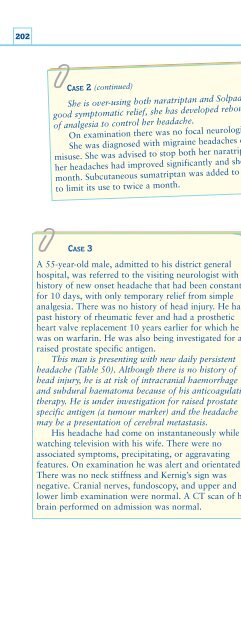You also want an ePaper? Increase the reach of your titles
YUMPU automatically turns print PDFs into web optimized ePapers that Google loves.
202CASE 2 (continued)She is over-using both naratriptan and Solpadol medication. Although Solpadol is giving hergood symptomatic relief, she has developed rebound headache and is requiring increasing dosesof analgesia to control her headache.On examination there was no focal neurological deficit and fundoscopy was normal.She was diagnosed with migraine headaches complicated by analgesic and naratriptanmisuse. She was advised to stop both her naratriptan and Solpadol medication. After 4 monthsher headaches had improved significantly and she was having only two attacks of migraine amonth. Subcutaneous sumatriptan was added to her prophylactic treatment and she was advisedto limit its use to twice a month.CASE 3A 55-year-old male, admitted to his district generalhospital, was referred to the visiting neurologist with ahistory of new onset headache that had been constantfor 10 days, with only temporary relief from simpleanalgesia. There was no history of head injury. He had apast history of rheumatic fever and had a prostheticheart valve replacement 10 years earlier for which hewas on warfarin. He was also being investigated for araised prostate specific antigen.This man is presenting with new daily persistentheadache (Table 50). Although there is no history ofhead injury, he is at risk of intracranial haemorrhageand subdural haematoma because of his anticoagulationtherapy. He is under investigation for raised prostatespecific antigen (a tumour marker) and the headachemay be a presentation of cerebral metastasis.His headache had come on instantaneously whilewatching television with his wife. There were noassociated symptoms, precipitating, or aggravatingfeatures. On examination he was alert and orientated.There was no neck stiffness and Kernig’s sign wasnegative. Cranial nerves, fundoscopy, and upper andlower limb examination were normal. A CT scan of hisbrain performed on admission was normal.The sudden onset suggests a vascularcause and SAH needs to be excludedurgently. The normal CT scan and lack offocal deficit, neck stiffness, and reducedlevel of consciousness are not totallyreassuring and do not exclude SAH.Following the administration of freshfrozen plasma to temporarily reverse hiswarfarin, he had a LP performed whichwas abnormal and consistent with a latediagnosis of SAH. Four-vessel cerebralangiography was performed, but noevidence of cerebral aneurysm orarteriovenous malformation was found. Hisheadache settled spontaneously andcompletely.Some patients with proven SAH do nothave a radiologically demonstrable aneurysmor vascular malformation; prognosis here isfavourable with negligible recurrence rates.
















